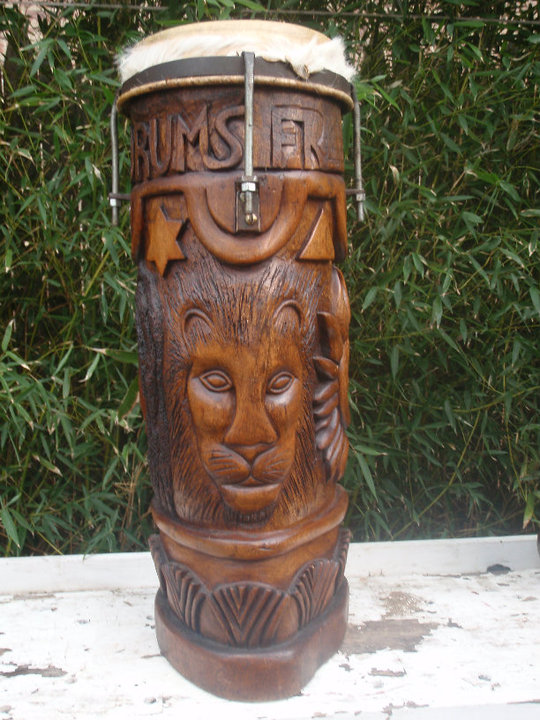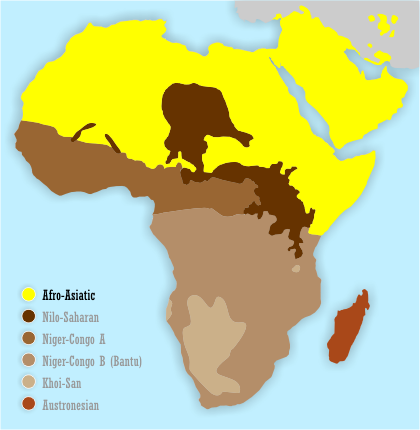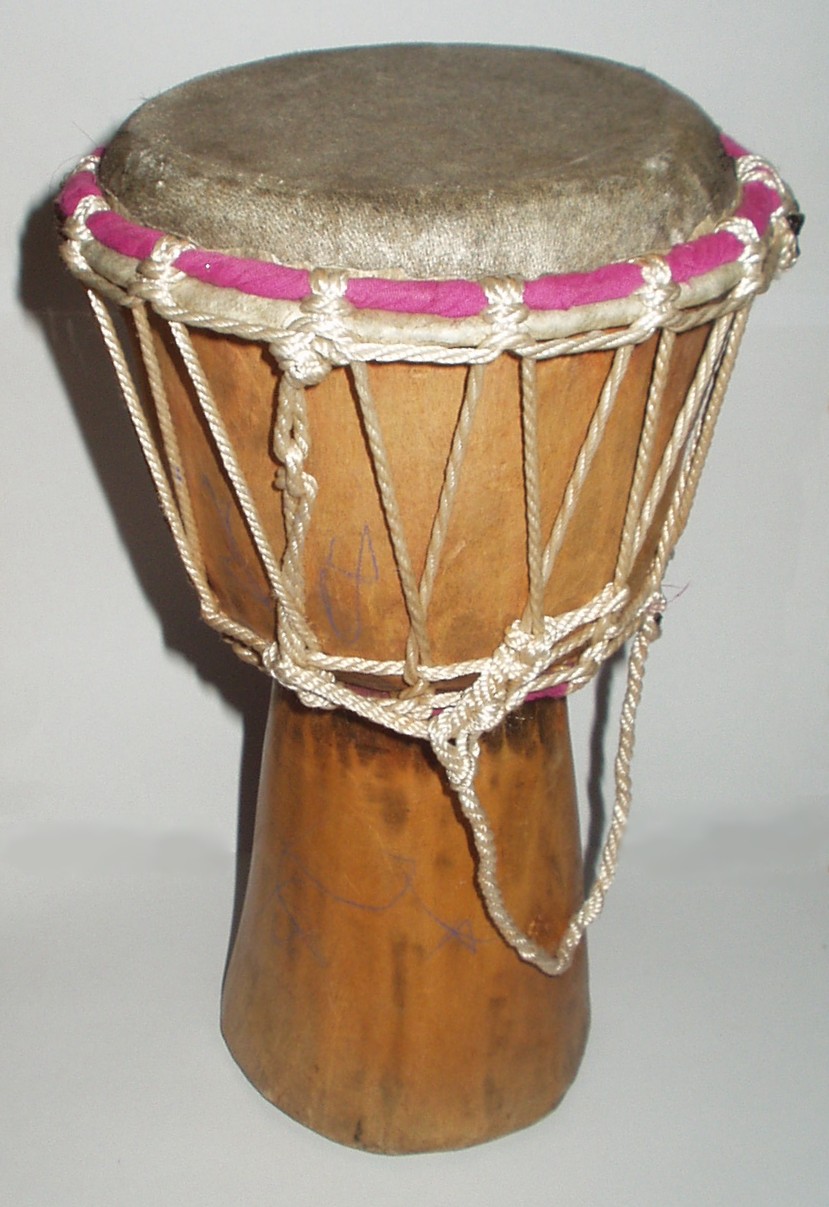African drums on:
[Wikipedia]
[Google]
[Amazon]




 Many Sub-Saharan languages do not have a word for ''rhythm'', or even ''music''. Rhythms represent the very fabric of life and embody the people's interdependence in human relationships. Cross-beats can symbolize challenging moments or emotional stress: playing them while fully grounded in the main beats prepares one for maintaining life-purpose while dealing with life's challenges. The sounding of three beats against two is experienced in everyday life and helps develop "a two-dimensional attitude to rhythm". Throughout Western and Central Africa child's play includes games that develop a feeling for multiple rhythms. Because African music is not set apart from its social and cultural context, it is a mistake for Westerners to listen to African music in the same way in which they would listen to Western (European) music.
Among the characteristics of the Sub-Saharan African approach to rhythm are
Many Sub-Saharan languages do not have a word for ''rhythm'', or even ''music''. Rhythms represent the very fabric of life and embody the people's interdependence in human relationships. Cross-beats can symbolize challenging moments or emotional stress: playing them while fully grounded in the main beats prepares one for maintaining life-purpose while dealing with life's challenges. The sounding of three beats against two is experienced in everyday life and helps develop "a two-dimensional attitude to rhythm". Throughout Western and Central Africa child's play includes games that develop a feeling for multiple rhythms. Because African music is not set apart from its social and cultural context, it is a mistake for Westerners to listen to African music in the same way in which they would listen to Western (European) music.
Among the characteristics of the Sub-Saharan African approach to rhythm are
 African music relies heavily on fast-paced, upbeat rhythmic drum playing found all over the continent, though some styles, such as the
African music relies heavily on fast-paced, upbeat rhythmic drum playing found all over the continent, though some styles, such as the
 Key patterns, also known as '' bell patterns, timeline patterns, guide patterns'' and ''phrasing referents'' express a rhythm's organizing principle, defining rhythmic structure and epitomizing the complete rhythmic matrix. They represent a condensed expression of all the movements open to musicians and dancers. Key patterns are typically clapped or played on idiophones such as bells, or else on a high-pitched drumhead. Musics organized around key patterns convey a two-celled (binary) structure, a complex level of African cross-rhythm.
Key patterns, also known as '' bell patterns, timeline patterns, guide patterns'' and ''phrasing referents'' express a rhythm's organizing principle, defining rhythmic structure and epitomizing the complete rhythmic matrix. They represent a condensed expression of all the movements open to musicians and dancers. Key patterns are typically clapped or played on idiophones such as bells, or else on a high-pitched drumhead. Musics organized around key patterns convey a two-celled (binary) structure, a complex level of African cross-rhythm.
 The most basic duple-pulse figure found in Sub-Saharan African music is a figure the Cubans call ''tresillo'', a Spanish word meaning 'triplet'. The basic figure is also found within a wide geographic belt stretching from Morocco in North Africa to Indonesia in South Asia. This pattern may have migrated east from North Africa to Asia with the spread of
The most basic duple-pulse figure found in Sub-Saharan African music is a figure the Cubans call ''tresillo'', a Spanish word meaning 'triplet'. The basic figure is also found within a wide geographic belt stretching from Morocco in North Africa to Indonesia in South Asia. This pattern may have migrated east from North Africa to Asia with the spread of
"The Myth of Cross-Rhythm"
''Foundation Course in African Dance-Drumming'' (webpage, accessed 24 April 2010).


Sub-Saharan African music
In many parts of sub-Saharan Africa, the use of music is not limited to entertainment: it serves a purpose to the local community and helps in the conduct of daily routines. Traditional African music supplies appropriate music and dance for work ...
is characterised by a "strong rhythmic interest" that exhibits common characteristics in all regions of this vast territory, so that Arthur Morris Jones (1889–1980) has described the many local approaches as constituting ''one main system''. C. K. Ladzekpo also affirms the ''profound homogeneity'' of approach. West African rhythmic techniques carried over the Atlantic were fundamental ingredients in various musical styles of the Americas: samba
Samba (), also known as samba urbano carioca (''urban Carioca samba'') or simply samba carioca (''Carioca samba''), is a Brazilian music genre that originated in the Afro-Brazilian communities of Rio de Janeiro in the early 20th century. Havin ...
, forró, maracatu and coco in Brazil, Afro-Cuban music and Afro-American musical genres such as blues
Blues is a music genre and musical form which originated in the Deep South of the United States around the 1860s. Blues incorporated spirituals, work songs, field hollers, shouts, chants, and rhymed simple narrative ballads from the Afr ...
, jazz, rhythm & blues
Rhythm and blues, frequently abbreviated as R&B or R'n'B, is a genre of popular music that originated in African-American communities in the 1940s. The term was originally used by record companies to describe recordings marketed predominantly ...
, funk
Funk is a music genre that originated in African American communities in the mid-1960s when musicians created a rhythmic, danceable new form of music through a mixture of various music genres that were popular among African Americans in the m ...
, soul, reggae, hip hop, and rock and roll were thereby of immense importance in 20th century popular music. The drum is renowned throughout Africa.
Rhythm in Sub-Saharan African culture


 Many Sub-Saharan languages do not have a word for ''rhythm'', or even ''music''. Rhythms represent the very fabric of life and embody the people's interdependence in human relationships. Cross-beats can symbolize challenging moments or emotional stress: playing them while fully grounded in the main beats prepares one for maintaining life-purpose while dealing with life's challenges. The sounding of three beats against two is experienced in everyday life and helps develop "a two-dimensional attitude to rhythm". Throughout Western and Central Africa child's play includes games that develop a feeling for multiple rhythms. Because African music is not set apart from its social and cultural context, it is a mistake for Westerners to listen to African music in the same way in which they would listen to Western (European) music.
Among the characteristics of the Sub-Saharan African approach to rhythm are
Many Sub-Saharan languages do not have a word for ''rhythm'', or even ''music''. Rhythms represent the very fabric of life and embody the people's interdependence in human relationships. Cross-beats can symbolize challenging moments or emotional stress: playing them while fully grounded in the main beats prepares one for maintaining life-purpose while dealing with life's challenges. The sounding of three beats against two is experienced in everyday life and helps develop "a two-dimensional attitude to rhythm". Throughout Western and Central Africa child's play includes games that develop a feeling for multiple rhythms. Because African music is not set apart from its social and cultural context, it is a mistake for Westerners to listen to African music in the same way in which they would listen to Western (European) music.
Among the characteristics of the Sub-Saharan African approach to rhythm are syncopation
In music, syncopation is a variety of rhythms played together to make a piece of music, making part or all of a tune or piece of music off-beat. More simply, syncopation is "a disturbance or interruption of the regular flow of rhythm": a "place ...
and '' cross-beats'' which may be understood as sustained and systematic polyrhythms, an ostinato
In music, an ostinato (; derived from Italian word for ''stubborn'', compare English ''obstinate'') is a motif or phrase that persistently repeats in the same musical voice, frequently in the same pitch. Well-known ostinato-based pieces include ...
of two or more distinct rhythmic figures, patterns or phrases at once. The simultaneous use of contrasting rhythmic patterns within the same scheme of accents or meter lies at the core of African rhythmic tradition. All such "asymmetrical" patterns are historically and geographically interrelated.
As a result of the migrations of Niger-Congo peoples (e.g., Bantu expansion
The Bantu expansion is a hypothesis about the history of the major series of migrations of the original Proto-Bantu-speaking group, which spread from an original nucleus around Central Africa across much of sub-Saharan Africa. In the process, t ...
), polyrhythmic culture (e.g., dance
Dance is a performing art form consisting of sequences of movement, either improvised or purposefully selected. This movement has aesthetic and often symbolic value. Dance can be categorized and described by its choreography, by its repertoir ...
, music), which is generally associated with being a common trait among modern cultures of Africa, spread throughout Africa. Due to the Trans-Atlantic slave trade, music of the African diaspora
Music of the African diaspora was mostly refined and developed during the period of slavery. Slaves did not have easy access to instruments, so vocal work took on new significance. Through chants and work songs people of African descent preserved e ...
, many of whom descend from Niger-Congo peoples, has had considerable influence upon modern Western forms of popular culture (e.g., dance
Dance is a performing art form consisting of sequences of movement, either improvised or purposefully selected. This movement has aesthetic and often symbolic value. Dance can be categorized and described by its choreography, by its repertoir ...
, music).
Instruments
 African music relies heavily on fast-paced, upbeat rhythmic drum playing found all over the continent, though some styles, such as the
African music relies heavily on fast-paced, upbeat rhythmic drum playing found all over the continent, though some styles, such as the Township music
Township Jazz is any of various music genres created by Bantu peoples living in poor, racially segregated urban areas of South Africa ("townships") during the 20th century.
The principal genres of township music are mbaqanga, kwela, and marabi. ...
of South Africa do not make much use of the drum and nomadic groups such as the Maasai do not traditionally use drums. Elsewhere the drum is the sign of life: its beat is the heartbeat of the community.
Drums are classed as membranophones and consist of a skin or "drumhead" stretched over the open end of a frame or "shell". Well known African drums include the djembe
A djembe or jembe ( ; from Maninka language, Malinke ''jembe'' , N'Ko script, N'Ko: ) is a rope-tuned skin-covered goblet drum played with bare hands, originally from West Africa.
According to the Bambara people in Mali, the name of the djembe ...
and the talking drum
Many aspects of African drumming, most notably time-keeping, stem from instruments such as shakers made of woven baskets or gourds or the double bell
A double is a look-alike or doppelgänger; one person or being that resembles another.
Double, The Double or Dubble may also refer to:
Film and television
* Double (filmmaking), someone who substitutes for the credited actor of a character
* Th ...
, made of iron and creating two different tones. Each region of Africa has developed a different style of double bell but the basic technology of bell-making is the same all over the continent, as is often the bell's role as time keeper. The South American agogo is probably a descendant from these African bells. Other idiophones include the Udu and the slit drum or log drum.
Tuned instruments such as the mbira and the marimba often have a short attack and decay that facilitates their rhythmic role.
Cross-rhythm
African rhythmic structure is entirely divisive in nature but may divide time into different fractions at the same time, typically by the use of hemiola or ''three-over-two'' (3:2), which Novotney has called the foundation of all West African polyrhythmic textures. It is the interplay of several elements, inseparable and equally essential, that produces the "varying rhythmic densities or motions" of cross-rhythmic texture. 3 and 2 belong to a single Gestalt. Cross-rhythm is the basis for much of the music of the Niger–Congo peoples, speakers of the largest language family in Africa. For example, it "pervades southern Ewe music".Key patterns
 Key patterns, also known as '' bell patterns, timeline patterns, guide patterns'' and ''phrasing referents'' express a rhythm's organizing principle, defining rhythmic structure and epitomizing the complete rhythmic matrix. They represent a condensed expression of all the movements open to musicians and dancers. Key patterns are typically clapped or played on idiophones such as bells, or else on a high-pitched drumhead. Musics organized around key patterns convey a two-celled (binary) structure, a complex level of African cross-rhythm.
Key patterns, also known as '' bell patterns, timeline patterns, guide patterns'' and ''phrasing referents'' express a rhythm's organizing principle, defining rhythmic structure and epitomizing the complete rhythmic matrix. They represent a condensed expression of all the movements open to musicians and dancers. Key patterns are typically clapped or played on idiophones such as bells, or else on a high-pitched drumhead. Musics organized around key patterns convey a two-celled (binary) structure, a complex level of African cross-rhythm.
The standard pattern
The most commonly used key pattern in sub-Saharan Africa is the seven-stroke figure known in ethnomusicology as the ''standard pattern''. The standard pattern, composed of two cross-rhythmic fragments, is found both in simple ( or ) and compound ( or ) metrical structures. Until the 1980s, this key pattern, common in Yoruba music, Ewe music and many other musics, was widely interpreted as composed of additive groupings. However the standard pattern represents not a series of durational values, but a series of attack points that divide the fundamental beat with a cross-rhythmnic structure.Tresillo
 The most basic duple-pulse figure found in Sub-Saharan African music is a figure the Cubans call ''tresillo'', a Spanish word meaning 'triplet'. The basic figure is also found within a wide geographic belt stretching from Morocco in North Africa to Indonesia in South Asia. This pattern may have migrated east from North Africa to Asia with the spread of
The most basic duple-pulse figure found in Sub-Saharan African music is a figure the Cubans call ''tresillo'', a Spanish word meaning 'triplet'. The basic figure is also found within a wide geographic belt stretching from Morocco in North Africa to Indonesia in South Asia. This pattern may have migrated east from North Africa to Asia with the spread of Islam
Islam (; ar, ۘالِإسلَام, , ) is an Abrahamic religions, Abrahamic Monotheism#Islam, monotheistic religion centred primarily around the Quran, a religious text considered by Muslims to be the direct word of God in Islam, God (or ...
: use of the pattern in Moroccan music can be traced back to Trans-Saharan exchanges during the Green Sahara.This influence increased due to slaves brought north across the Sahara Desert from present-day Mali. In African music, this is a cross-rhythmic fragment generated through cross-rhythm: 8 pulses ÷ 3 = 2 cross-beats (consisting of three pulses each) with a remainder of a partial cross-beat (spanning two pulses). In divisive form, the strokes of tresillo contradict the beats while in additive form, the strokes of tresillo ''are'' the beats. From a metrical perspective, the two ways of perceiving tresillo constitute two different rhythms. On the other hand, from the perspective of the pattern of attack-points, tresillo is a shared element of traditional folk music from the northwest tip of Africa to southeast tip of Asia.
References
Sources
* *Novotney, Eugene D. (1998). ''The Three Against Two Relationship as the Foundation of Timelines in West African Musics''. Urbana, IL: University of Illinois. * *Ladzekpo, C. K. (1995)"The Myth of Cross-Rhythm"
''Foundation Course in African Dance-Drumming'' (webpage, accessed 24 April 2010).
Further reading
*Godfried T. Toussaint, "On the question of meter in African rhythm: A quantitative mathematical assessment", In ''Proceedings of Bridges: Mathematics, Music, Art, Architecture, and Culture'', G. Hart and R. Sarhangi, (Eds.), Enschende, The Netherlands, 27–31 July 2013, pp. 559–562, Phoenix: Tessellations Publishing. {{DEFAULTSORT:African Drumming African drums African music African rhythm Sub-Saharan Africa